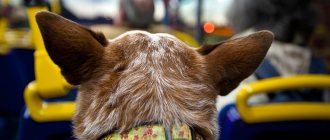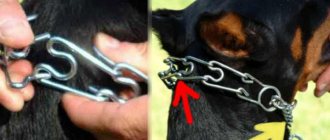Hello, dear readers! When going on vacation, dog owners are faced with a dilemma: take the animal with them or leave it at home. There are times when you don't have to choose. Travel with your pet; there is nothing wrong with transporting dogs on the train, especially since the rules have been significantly simplified in 2022.
In this article I will tell you how to take a dog on a train in Russia. I will not touch on the conditions for traveling with an animal abroad. But keep in mind that for each country, the set of documents may be different.
general information
- Transportation rules in Russia depend on the size of the dog and the category of the train.
- The categories of “large” or “small” dog are determined based on the weight of the pet. “Small” dogs include dogs weighing no more than 20 kg.
- Tickets can be purchased for any category of pets at the railway ticket office.
- Documents and certificates from veterinary hospitals for small dogs are no longer required. The new rule was introduced in January 2022. You can read more here.
- Feeding and caring for a four-legged friend on the go is the responsibility of the owner. The owner himself ensures compliance with sanitary and hygienic standards and conditions and does not allow damage to Russian Railways property.
- Guide dogs travel free of charge without any special documents or certificates, together with the owner, muzzled and on a leash; they must be located next to the feet of the person who is carrying them.
What animals can be transported?
On Russian Railways trains (specifically, in carriages owned by JSC FPC), the following types of animals can be transported as hand luggage:
- large dogs (only with a leash and muzzle);
- small domestic and indoor animals in cages and other containers - cats, small dogs, ornamental pigs, fennec foxes;
- primates in cages - lemurs, lorises and other small monkeys;
- small rodents in cages (from ordinary mice and rats to decorative rabbits and chinchillas);
- aquarium fish (in aquariums);
- arthropods in terrariums - crayfish, non-poisonous spiders, butterflies, etc.;
- insectivores (hedgehogs) and small predators - raccoons, ferrets, minks;
- non-poisonous amphibians (frogs, tree frogs, newts) and reptiles (iguanas, turtles, lizards, chameleons) - in containers, cages, terrariums;
- birds in cages;
- decorative mollusks in aquariums (as well as leeches).
Transportation rules prohibit the following animals from being carried in passenger carriages along with hand luggage:
- any animals and birds that may threaten the health or life of passengers or employees of Russian Railways;
- animals are dirty and/or have an unpleasant odor;
- wild (undomesticated) and farm animals;
- sick and experimental animals;
- animals not accustomed to long journeys in cages or containers;
- animals that act restless or threatening.
How to carry a dog on a train?
The easiest way to carry a dog is on commuter trains. Pets of any size are required to pay a ticket. The cost depends on the distance of the journey. Veterinary certificates are not required. Regardless of size, animals must be muzzled and on a leash under the strict supervision of the owner. Large dogs are allowed to be transported only in vestibules, and the number of pets should be no more than two per carriage.
Taxi
The ride of animals in a taxi is regulated by the Decree “On approval of the rules for the provision of passenger road transport services,” which requires that transportation be organized in such a way that legal and safety standards are met. In other words, the conditions are set by the carrier company.
As a general rule, animals of any size are transported in a cage or muzzle. Some companies may require the presentation of veterinary documents to ensure that the animal does not have infectious diseases.
If you are planning a taxi trip, it is better to find out from the dispatcher what requirements apply to the tailed passenger and the cost of the trip.
Travel on long-distance trains
Do you need any certificates?
As I wrote above, in order to travel by train with a “small” breed dog from the beginning of 2022, you no longer need to issue special veterinary certificates, but only if the animal’s owner has not changed or the transportation is not related to commercial activities.
Therefore, all the fuss with long registration can be avoided. However, you understand that conductors are different and so are passengers. Accordingly, it is better to take with you an international veterinary passport with a stamp on vaccination against rabies and deworming. In principle, I think all owners do it, so there shouldn’t be any problems with it. Let me remind you that the vaccination must be given at least a month before the trip, this is the incubation period. And deworming is carried out two weeks before vaccination, calculate the time. (Marks can be made at any veterinarian). Other types of vaccinations are optional, and there is no need to issue a veterinary health certificate in Form No. 1.
Important! Not all carriage service categories allow dogs. The class of service is indicated on the ticket, be sure to check before purchasing.
Conditions for transporting dogs up to 20 kg
| Car type and class of service | Transportation rules |
| Lux 1D, 1I, 1M | Transportation only in containers. Free if 2nd place is redeemed. With payment - for each seat exceeding the number of passengers traveling in the compartment. You can transport no more than two animals. |
| SV 1B | No more than 2 animals in one carrier, regardless of the number of passing passengers - free of charge. |
| SV 1E | Free, under the same conditions as in Lux cars. |
| SV 1E, 1U, 1L | It is necessary to purchase all compartments, dog transportation is free. |
| Coupe 2E, 2B | Repurchase of all seats is required. There is no need to pay for the transportation of the animal itself. |
| Coupe 2K, 2U, 2L | You need your own ticket, you don’t need to buy all your seats. Carrying is required. |
| 3D reserved seat | Separate ticket, no need to buy additional seats. You need to bring your pet in a carrier. |
| Seated carriage 1B (soft chairs and table) | Free with purchase of all adjacent seats. |
| General carriage 3O | Paid, no need to buy neighboring seats. |
The tables indicate only carriages in which dogs can be transported under certain conditions. In all other types, the transportation of animals is not provided. The tables are compiled taking into account the new rules 2022.
Attention! All data was taken on July 31, 2017 from the official website of Russian Railways. These may change, so be sure to check before purchasing tickets.
Conditions for transporting dogs over 20 kg
| Car type and service category | Transportation rules |
| SV 1B | You can bring one dog, the purchase of a second place is required. Regardless of the number of passengers in the compartment, you do not have to pay extra for a pet. |
| SV 1E, 1L, 1U | You can only bring one dog, subject to the purchase of all seats. There is no need to pay for the transportation of the animal itself. |
| Coupe 2E, 2B | You can only bring one dog, subject to the purchase of all seats. There is no need to pay for the transportation of the animal itself. |
| Coupe for 4 seats categories 2K, 2U, 2L | All seats in the compartment are purchased, the dog itself is free. The number of pets and people must be equal to the number of seats in the compartment. You are allowed to bring no more than 2 dogs. |
Where and how to buy a train ticket for a dog?
- You cannot buy a ticket for your dog online. It is sold only at the box office upon presentation of the owner's ticket. But according to the new rules (01/13/2017), it can be redeemed in advance, and not 24 hours in advance, as before.
- If you first buy a ticket for yourself, warn the cashier that you are planning to travel with a dog. Without knowing this, the cashier may sell you a seat in the carriage where you cannot take an animal. In any case, when purchasing, check the service category of the carriage.
- If you bought yourself an electronic ticket, then when buying a ticket for your dog, you need to print it out and present it at the box office. Veterinary certificate form No. 1 no longer needs to be provided.
- If your dog is not very large and visually, let’s say, does not look bulky, then no one will weigh it when boarding, so at the checkout you quote any weight up to 20 kg.
- The ticket price depends on the distance of the train; you can find it on the Russian Railways website. Tariffs for 2022 can be found here.
Legislative regulation
If you are not allowed on a train with an animal, two points are considered. The first is that you have not carried out all the preparatory measures regarding the documents. Secondly, you simply forgot the animal at home.
Knowing and observing all the requirements that are needed to transport a cat on a train, the conductor will not reprimand you, and certainly will not refuse to board the carriage. Everything is explained by Russian legislation.
At the moment - in 2022 - there are two legislative acts regulating the transportation of pets on trains.
— The first act is Federal Law No. 18 of January 2003. This bill approves the rights and requirements for persons who have purchased a train ticket. They automatically become passengers in the vehicle in question and are responsible for complying with safety requirements.
— The second act is Order of the Ministry of Transport of the Russian Federation No. 473 of December 2013. Here are the regulations for the transportation of passengers and animals by Russian Railways.
It follows from both legislative acts that you can transport a cat on a train. To do this, you just need to follow the rules.
Rules for carriage on high-speed trains
In this type of train, it is possible to transport only small breeds that fit in a carrier with a total size of 180 cm (length + height + width), and in some cases, the container should not exceed 120 cm in the sum of all dimensions; breeds heavier than 20 kg are prohibited from being carried.
Peregrine Falcon
In Sapsan you can take no more than one dog per ticket and no more than two animals per seat. Conditions and payment for transportation depend on the passenger's ticket class:
- For economy class passengers - carriage No. 3 (1,2,3,4 seats), the ticket price for these seats already includes the cost of transporting an animal. Pets can only be transported in a carrier (the sum of 3 dimensions is no more than 180 cm) in special places intended for hand luggage.
- Passengers of “first” and “business” class carriages must also place their dog in carriage No. 3. The animal will be under the supervision of a conductor in specially designated places opposite seats No. 65 and 66. The service is paid separately (900 rubles) and is ordered no later than 2 days before the train departure. The container with the animal must weigh no more than 10 kg, its size in three dimensions must not exceed 120 cm.
- The meeting compartment also has space for those traveling with a dog - 1 carriage (27, 28, 29, 30 seats). It is necessary to buy all the compartments. The container size is the same as for first class passengers. There is no charge for transporting animals.
Attention! Transportation of large breed dogs is not provided in Sapsan.
Martin
In Lastochki, “standard” and “premium” passengers are allowed to transport small breeds in carriers with a total size of 180 cm; a flat fee of 150 rubles is charged for transportation, which is initially included in the ticket price. There is no need to pay for adjacent seats. Transportation of animals is possible in carriages No. 5 and 10; there are separate conditions for carriages of class 2B.
How to carry dogs on other trains, see here.
Traveling abroad with a pet
If you have to cross the Russian border, then you should take into account that the rules for transporting animals abroad may differ. For example, in Belarus you can only travel with them in compartment cars. The EU countries also have their own nuances, which are best clarified in advance. In addition, for each animal you will have to issue a veterinary certificate in two languages (Russian and the country of entry). In addition, additional vaccinations and documentation may be required. It is noteworthy that the import of pets into Norway and the UK is generally prohibited. In East Asian countries (China, Mongolia, Vietnam, etc.), animals are allowed to travel only in 2nd class carriages. The same rule applies to guide dogs.
10 BEST DOG BREEDS FOR CHILDREN AND FAMILIES
TOP 10 MOST DANGEROUS DOG BREEDS
THE SMARTEST DOG BREEDS
THE SMALLEST DOG BREEDS
Useful tips
Remember that traveling on a train is very stressful for an animal; its behavior and condition can change dramatically. To ensure your trip goes smoothly, consider the following tips:
- Buy special sedatives for dogs, they come in tablets or drops. Start giving them a week before departure, the medications have a cumulative effect.
- The last meal should be no later than the day before departure. On the train there is a high risk of motion sickness, the dog may vomit, and in general it will feel bad with a full stomach. It is important to take more drinking water.
- Don't forget to walk your pet right before boarding. There are no conditions in the carriage for animals, and it will be hard for them to endure “what’s left.” Buy special dog diapers that can be placed in the bottom of the carrier.
- Be sure to purchase a comfortable muzzle. He must be free, the tailed friend must be able to open his mouth easily and wide. The carriages are usually very stuffy, plus the pet is nervous. Do not use narrow cloth muzzles.
- Choose daytime for your trip, as it is more difficult to monitor the animal at night. And it is advisable that the duration of the trip is no more than a day. If the distance is too long, it is better to buy a plane ticket. To learn how to prepare for a flight, read the article “What documents are needed to transport a dog on an airplane?”
Tail Style
The shape, length and thickness of a dog's tail provide little information about its origin.
It is important to distinguish between a naturally curled tail and a couped tail. Some dogs, such as Dobermans, Boxers and English Pointers, have their tails fixed at an early age
It may be surprising to see one of these breeds without a docked tail, but progressive veterinary care is moving in this direction (especially for non-working dogs).
Several dozen dog breeds have the bobtail genetic mutation. These breeds include the Australian Shepherd, Brittany Spaniel and Jack Russell Terrier. Dog breeds that do not have the mutation but naturally have bobtails include Boston Terriers, English Bulldogs, King Charles Spaniels, Miniature Schnauzers and Rottweilers.
The ring tail is full, and arches over the dog's back. The crescent tail also curves over the dog's back, but points towards the head. The screw tail resembles a corkscrew tail (characteristic of pugs), and the otter tail resembles just that - an otter tail. The otter's tail is thick and full and acts like a rudder in the water. These tails are characteristic of your water-loving dog, the Labrador. The tail of the whip is long, thin and straight.
Questions and answers
How comfortable and safe is it to take a dog on a train?
For the dog itself, such an event is stressful, and for you too. To avoid causing more problems for your pet, follow the tips above. Chat with her, pet her, offer water. But without fanaticism, because if the animal feels bad, your importunity will only do harm.
It is advisable to protect her from communication with her fellow passengers. This way you will avoid problematic situations: she won’t bark at anyone, won’t scare anyone, etc.
In general, if all precautions are followed, traveling by train does not cause any particular problems.
In what type of carriage is it better to transport an animal?
The most reasonable option is to take the dog in the compartment. Whether to buy neighboring places or not depends on the size of the pet and your desire. But even without buying seats, this method will cause her less stress: a limited number of people, her own place, the ability to close the doors.
Carrying requirements
There are no fundamental requirements for carrying, except that there is no point in a box whose three dimensions exceed 180 centimeters, otherwise you will have to buy the entire compartment
You should also pay attention to the fact that you cannot carry more than two animals in one box, and if there are suddenly more dogs, you will have to buy additional baskets
In this case, the cell must meet certain logical criteria. For example, during a short trip, it is still acceptable not to feed the dog on the road, but any dog lover will confirm that the animal must have constant and free access to drinking water, so there must be a drinking bowl inside.
Carrying it should be extremely comfortable, because you will have to carry it in your hands for some part of the journey. It is included in the list of mandatory requirements in order to protect surrounding passengers from possible aggression from the dog, therefore you must be sure that a man’s friend will not be able to show hostility towards any of his neighbors either with his teeth or his paw. At the same time, the vessel cannot be airtight - you need to make sure that ventilation inside is normal and the animal will not suffer from suffocation.
The most difficult moment is associated with the toilet. Since you are traveling by public transport, the bottom of the carrier definitely should not be permeable - if the dog considers it possible to go under himself, let the negative for those around him be limited only to the smell, but not the scandal and the sight of you cleaning. It is desirable that the box has a fairly high, impenetrable side, which will protect the interior of the car from the dog’s waste.
At the same time, for absorbency, you can put some soft rag on the bottom if you are sure that the dog’s trip to the toilet is inevitable. Combined with disposable hygiene bags, similar to those used by parents of infants when traveling, this may be the only solution to maintaining hygiene on a long journey.
Documents for transporting a cat
It is necessary to carefully consider how to transport a cat on a train in Russia, regarding the required documents.
Until 2022, having a veterinary passport for an animal was mandatory. Without it, it was impossible to purchase a train ticket. Now there is no need for this, although the relaxation does not apply to all cases:
- The Russian border crosses with a cat only if it has a veterinary passport and a stamp indicating that it has been vaccinated.
- In business classes and high-speed trains, where the cat is placed with other animals, conductors require a veterinary passport.
- Transporting a cat to an exhibition also requires the presentation of a veterinary passport.
It follows that it is better to obtain a veterinary passport for the animal in advance and vaccinate it. This will protect your pet from infection on the road.











